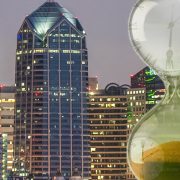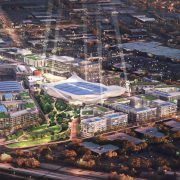Office Outlook: Dark Skies Now, Sunny Skies Ahead
The adage, “It’s always darkest before the dawn,” seems like an accurate assessment of the current office market. Despite record vacancy levels across the country, there are some positive indicators as we head into the final quarter.
The Bad News
Let’s start with the bad news. According to Moody’s Analytics, the office sector set a record vacancy rate of 20.1% in Q2, up from 19.8% in Q1. This represents the third straight record-breaking quarter and the first time in history that the rate broke the 20% barrier. The previous historic peak rate was 19.3% in 1986 and 1991, despite a strong economy, unemployment around 4.0%, and GDP growth at pre-pandemic levels.
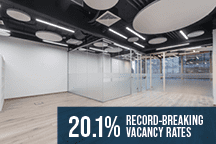
Asking rents grew by 0.3% for the quarter, primarily due to the continued strength of trophy properties. Effective rents fell by 0.1% in Q2 as landlords granted tenants greater concessions, continuing a negative or flat streak of four straight quarters. Effective rents have dropped by 0.5% in the last year after remaining positive in 2021 and 2022. Net absorption was 13.6 MSF in Q2, the worst performance since Q1 2021.
On the investment sales side, office continued its slide. According to MCSI’s RCA CPPI, the sector continued to register the largest annual decline in the property sector. In June, CBD office prices fell 24.7% from a year ago. Suburban office prices dropped 7.5%, although those declines were still an improvement over the magnitude of decreases seen over the past 12 months. Not surprisingly, prices for office properties declined by 9% over the past year, according to Green Street’s Commercial Property Price Index. Some office properties are expected to continue to fetch pennies on the dollar. The starkest example is the 23-story building at 135 West 50th Street in Midtown Manhattan. The property sold in 2006 for $332M and recently sold at an online auction for $8.5M at a 97.5% discount.
Commercial loan delinquencies for office properties are also on the rise. Fitch Ratings recently revised their U.S. CMBS office delinquency forecast upwards. They are projecting an 8.4% delinquency rate for 2024 and 11% for 2025. Both rates surpass the peak of the Global Financial Crisis (8.1%). Notably, the office delinquency rate was already up to 4.3% in April.
The Good News
While the immediate future of the office sector looks bleak, there are some positive trends to report. For starters, the long-awaited rate cuts appear to be on the way. Some economists predict as much as a 75 to 100 basis point reduction by year-end. While that may not spur an investment sales frenzy just yet, private investors sitting on dry powder see the current market as “one of the best opportunities in a generation to buy troubled U.S. real estate assets,” according to Nasdaq. And CoStar reports that “the capital markets are beginning to loosen as the pool of interested buyers begins to widen at a time of anticipated reduced interest rates and valuations that appear to have hit rock bottom.”
Through July, office sales have remained relatively flat year-over-year. CommercialEdge recorded office sales amounting to $17.1B through July traded at an average of $173 PSF. Office sales transactions last year totaled $17.5B and traded at $196 PSF. Most buildings sold continue to reflect deep discounts from valuations. This year, 28% of all office buildings that sold traded for a lower price than their previous recorded sale, up from 18% of all office transactions last year.
On the leasing side, there are some positive signs. According to Placer.ai, which tracks and analyzes foot traffic from mobile devices, 2024 office building foot traffic reached 72.2% of July 2019 levels. That is the highest foot traffic since the pandemic. However, the percentage varies from market to market. While New York and Miami are at 90% of pre-pandemic levels, the California markets of Los Angeles (62.7%) and San Francisco (52.8%) lag far behind. Although office use may never fully return to pre-pandemic levels, it marks a positive trend for property owners.
CoStar reports a national uptick in leasing activity and more confidence among tenants in their return-to-office plans. While there has not been a resurgence of large leases, and average deal sizes have shrunk, leasing activity has picked up in most markets, especially in Class A buildings. Class B and C buildings are faring less well. In addition, in Q2, demolitions and conversions once again exceeded new deliveries, and groundbreakings reportedly remained near historic lows.
Southern California
In most Southern California markets, the news is less sunny.
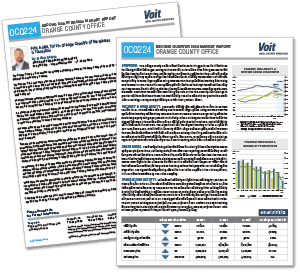
Orange County – The Orange County office market continued to struggle. Lease and sale activity by square footage and transaction count dropped by nearly 40% year over year, declining from 3,251,320 to 1,997,061 SF. The market appears to be improving when looking at the raw data for vacancy rates and asking rents. Yet, that is not the case. The vacancy rate declined by 70 bps from 17.04% to 16.34% (with an availability rate of 21.12%). However, that was primarily due to some larger spaces being removed from the speculative inventory after being sold to owners/users. Average asking lease rates improved from $2.64 to $2.76, but the effective rate, which includes concessions like free rent, over-standard tenant improvements, etc., moved down.
“Tenants are leveraging the current market conditions to negotiate better lease terms,” says Stefan Rogers, SVP/Partner in the Irvine office. “Cost reduction is a primary focus, with many businesses demanding rent concessions and flexible lease terms to lower their real estate expenses.”
Building sales were weak, and those that did sell did so at a steep discount. MGR Real Estate picked up the 271,100-square-foot office tower at 2020 Main Street in Irvine for $53.7M, nearly a quarter less than it traded for in 2001. The owner/user MicroVention acquired a 242,706 SF Aliso Viejo asset for $183 PSF, far below replacement cost.
For a more in-depth look at the Orange County office market, read Voit’s Q2 market report.
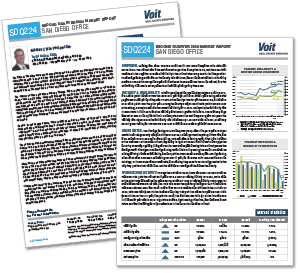
San Diego – The San Diego market has a vacancy rate far below many of the major U.S. metros at 12.81% and an availability rate of 17%, but that doesn’t tell the whole story. The 14 MSF Downtown market has a whopping 30.05% vacancy rate and a 37.59% availability rate. These rates are offset by some of the larger submarkets in San Diego County with single-digit vacancy rates, like the 11.4 MSF Kearney Mesa (7.88%) and the 8.5 MSF Sorrento Mesa (7.26%) submarkets. “There are only a handful of buildings downtown that have the ability to transact right now,” says associate Jessica Florin. “The lender for Regent Properties, which owns a number of buildings downtown, has frozen their ability to extend tenant improvement allowances, and the Irvine Company is pulling back on investing in their office properties at this time, so the East side of Downtown is in trouble.” There is a shortage of solid credit tenants, so tenants have a clear upper hand in negotiations.
While the downtown market faces significant challenges, many San Diego office markets are thriving. The 24 MSF North City market, which includes UTC and Sorrento Mesa, is sporting an 8.4% vacancy rate, the Central market is at 10.07%, and the Southern and Eastern areas are at a region-low 4.46%.
Construction remains robust in San Diego. 810,000 SF of new office buildings were delivered in 2024, with an additional 2 MSF of construction underway. The current surge in office construction will push the vacancy rate up, which will have the strongest direct impact on the market for larger tenants. For the county as a whole, we project increased vacancy in the coming quarters.
As far as building sales, there were a few significant office transactions in the second quarter that were acquired at steep discounts. These included the Sky Park Office Plaza, a two-building, 203.3 KSF office complex in Kearny Mesa that sold for nearly $19M after being acquired by Parallel Capital Partners/Angelo, Gordon, and Co. for $51M in 2019. Voit SVP/Partner Brandon Keith assisted CES Remington in acquiring the fully leased 48,571 SF Aerofund Financial Plaza for $9.8M, nearly $2M under the asking price.
Despite the turmoil in the San Diego office market, Keith is optimistic about the longer-term health of the San Diego office market. “Over the next couple of years, businesses will have largely ‘right-sized’ their office spaces to account for remote workers,” he says. “Obsolete and other distressed office property will be purchased for renovation or conversion (residential or other), resulting in less available office product in certain areas.”
For a more in-depth look at the San Diego office market, read Voit’s Q2 market report.
Los Angeles – According to CoStar, the average office vacancy rate in Los Angeles has increased by 70 basis points to 16.2% since January and 200 bps from the start of 2023. Occupancy losses are expected to persist for the next several years. Los Angeles remains a Top 10 market for investment sales (#7 at $617M through July, according to Commercial Edge) but has also seen some drastically discounted sales. In the spring, Brookfield Asset defaulted on the 777 S. Figueroa Street loan, which sold for about 50% less than the outstanding debt on the tower ($145M). In July, 801 S. Figueroa Street was sold to an unnamed Chinese investor for $60M ($129 PSF) by Barings, which had acquired the asset in 2014 for $197M.
For a more in-depth analysis of the all the Southern California office, industrial, R&D and retail markets, visit the Voit Market Reports page or contact one of Voit Real Estate Services’ trusted commercial real estate advisors.



